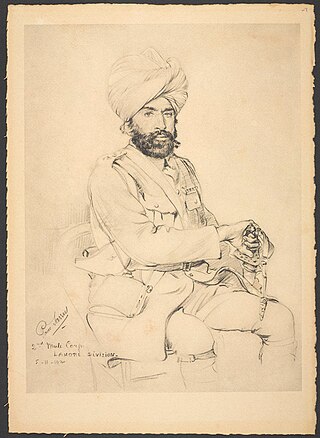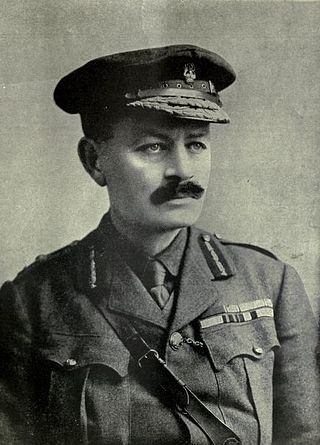Related Research Articles

The 4th Infantry Division, also known as the Red Eagle Division, is an infantry division of the Indian Army. This division of the British Indian Army was formed in Egypt in 1939 during the Second World War. During the Second World War, it took part in campaigns in East Africa, Syria, North Africa and Italy. Post independence, the division is part of the I Corps and headquartered at Prayagraj.

The 19th Infantry Division is an infantry division of the Indian Army.

The 10 RAPID Division was a war formed infantry division of the Indian Army during World War II. In four years, the division travelled over 4,000 miles (6,400 km) from Tehran to Trieste, fought three small wars, and fought two great campaigns: the Anglo-Iraqi War, the Invasion of Syria–Lebanon, the Anglo-Soviet invasion of Iran, the North African Campaign, and the Italian Campaign.
The 10th Indian Division was an infantry division of the British Indian Army during World War I. It was formed in Egypt in December 1914 with three infantry brigades of Indian Expeditionary Force F. After taking part in the Actions on the Suez Canal, the division was dispersed as its brigades were posted away.
Iraqforce was a British and Commonwealth formation that came together in the Kingdom of Iraq. The formation fought in the Middle East during World War II.
The Order of battle of the East African campaign shows the ground forces of both sides in East Africa on the date that the Italians declared war on Britain and France, 10 June 1940 and for the British and Commonwealth forces involved in the 1941 offensive.

The 15th Indian Division was an infantry division of the British Indian Army that saw active service in the First World War. It served in the Mesopotamian Campaign on the Euphrates Front throughout its existence. It did not serve in the Second World War, but was reformed at Dehradun in 1964 as part of the post-independence Indian Army.
The 4th (Quetta) Division was an infantry division of the British Indian Army. It was formed by General Kitchener while he was Commander-in-chief of India. During World War I the division remained in India. Its composition was:

The 7th (Meerut) Division was an infantry division of the Indian Army and before 1895, the Bengal Army, that saw active service during World War I.

The 3rd (Lahore) Division was an infantry division of the Indian Army and before 1895, the Bengal Army, first organised in 1852. It saw service during World War I as part of the Indian Corps in France before being moved to the Middle East where it fought against troops of the Ottoman Empire.
The 2nd (Rawalpindi) Division was a regular army division of the British Indian Army. It was formed in 1903 after the Kitchener reforms of the Indian Army. During World War I it remained in India for local defence but it was mobilised for action on the North West Frontier on several occasions during the period. The Division was mobilised in 1919 for service during the Third Afghan War.
The 14th Indian Division was formed during World War I, for service in the Mesopotamian Campaign. It was composed of battalions of the Regular British Army, the British Territorial Force and the British Indian Army.
This is the order of battle for the Syria–Lebanon campaign, a World War II campaign between the Western Allies and Vichy France during June and July, 1941.
The Peshawar Valley Field Force was a British field force. It was the largest of three military columns created in November 1878 at the start of the Second Anglo-Afghan War (1878–1880), each of which invaded Afghanistan by a different route. The Peshawar force initially consisted of around 16,000 men, a mix of both British and Indian Army regiments, under the command of Lieutenant General Sir Samuel J. Browne.
This is the order of battle for the First Battle of Ypres fought from 19 October to 22 November 1914 as one of the main engagements of the First World War. It was fought between mixed British Expeditionary Force, French eighth army and armies of the German Empire in northern France and Flanders.
In September 1939, the British Army was in process of expanding their anti-aircraft and mobile assets. Among these new changes was the formation of Anti-Aircraft Command which was formed on 1 April 1939, and the 1st Armoured Division formed in 1937. The list below will include the British Army units, colonial units, and those units which were in the process of formation.

The Force in Egypt was a British Army formation established in August 1914 to administer garrisoning armed forces in Egypt at the beginning of the First World War. The force had the objective of protecting the Suez Canal and was originally commanded by Major General Julian Byng, but he was replaced by General John Maxwell, who took command on 8 September 1914. Initially, the main threat to the Suez came from Germany and throughout the early months several of the force's elements were sent to Europe to take part in the fighting on the Western Front. On 5 November 1914, Britain and France declared war on the Ottoman Empire, after which the Force in Egypt faced a direct threat from Ottoman forces, which was realised in February 1915 with a raid on the Suez Canal. This threat remained until 1916 when the British forces went on the offensive.
The Structure of the Egyptian Expeditionary Force over the course of the First World War is shown below.
References
- Abbott, George Frederick (2009). Through India With the Prince (1906). Kessinger. ISBN 1-104-92594-X.